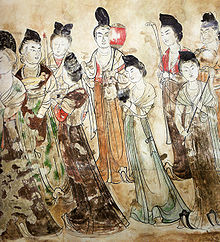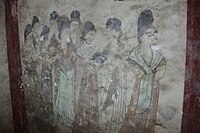
Year 706 (DCCVI) was a common year starting on Friday of the Julian calendar, the 706th year of the Common Era (CE) and Anno Domini (AD) designations, the 706th year of the 1st millennium, the 6th year of the 8th century, and the 7th year of the 700s decade. The denomination 706 for this year has been used since the early medieval period, when the Anno Domini calendar era became the prevalent method in Europe for naming years.
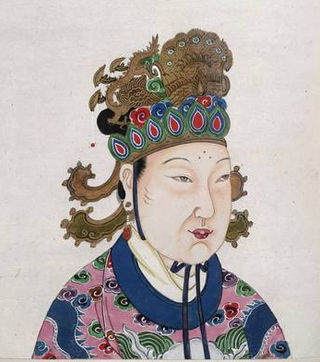
Wu Zetian, personal name Wu Zhao, was Empress of China from 660 to 705, ruling first through others and then in her own right. She ruled first as empress consort, through her husband Emperor Gaozong and then as an empress dowager, through her sons Emperors Zhongzong and Ruizong, from 660 to 690, not unprecedented in Chinese history. She subsequently founded and ruled as female emperor of the Wu Zhou dynasty of China from 690 to 705. She was the only female sovereign in the history of China widely regarded as legitimate. Under her 45-year reign, China grew larger, becoming one of the great powers of the world, its culture and economy were revitalized, and corruption in the court was reduced. She was eventually removed from power during a coup and died a few months later.

Emperor Xuanzong of Tang, personal name Li Longji, was an emperor of the Tang dynasty of China, reigning from 712 to 756 CE. His reign of 44 years was the longest during the Tang dynasty. Through two palace coups, he seized the throne and inherited an empire still in its golden age. He was initially assisted by capable chancellors like Yao Chong, Song Jing and Zhang Yue who were already serving as government officials before Xuanzong ascended the throne. However, under Emperor Xuanzong, the empire reached its turning point and went into sharp decline and near collapse, due to numerous political missteps throughout his long reign, such as over-trusting Li Linfu, Yang Guozhong and An Lushan, with Tang's golden age ending in the An Lushan Rebellion.
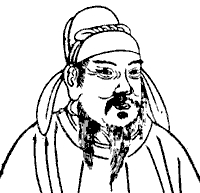
Emperor Zhongzong of Tang, personal name Li Xian, and at other times Li Zhe or Wu Xian, was the fourth and seventh emperor of the Tang dynasty of China, ruling briefly in 684 and again from 705 to 710. During the first period, he did not have actual power, which was in the hands of his mother, Empress Wu Zetian and he was overthrown on her orders after opposing his mother. During his second reign, most of the power was in the hands of his consort Empress Wei.
Princess Taiping (Chinese: 太平公主; pinyin: Tàipíng Gōngzhǔ, lit. "Princess of Great Peace", personal name unknown, possibly Li Lingyue was a royal princess and prominent political figure of the Tang dynasty and her mother Wu Zetian's Zhou dynasty. She was the youngest daughter of Wu Zetian and Emperor Gaozong and was influential during the reigns of her mother and her elder brothers Emperor Zhongzong and Emperor Ruizong, particularly during Emperor Ruizong's second reign, when for three years until her death, she was the real power behind the throne.
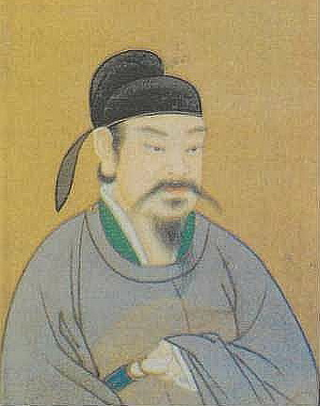
Emperor Ruizong of Tang, personal name Li Dan, also known at times during his life as Li Xulun, Li Lun, Wu Lun, and Wu Dan, was the fifth and ninth emperor of the Chinese Tang dynasty. He was the eighth son of Emperor Gaozong and the fourth son of Emperor Gaozong's second wife Empress Wu. He was wholly a figurehead during his first reign when he was controlled by his mother, and he was the titular and puppet ruler of the Tang Empire from 684 to 690. During his second reign after his mother's death, significant power and influence was exercised by his sister Princess Taiping.
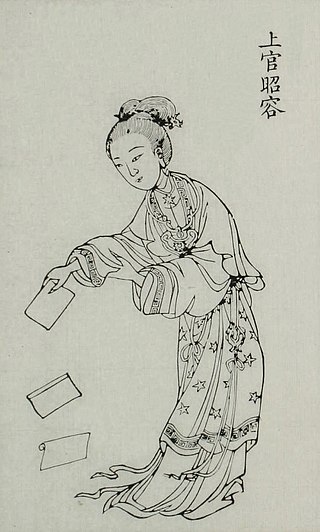
Shangguan Wan'er was a Chinese politician, poet, and imperial consort of the Wu Zhou and Tang dynasties. Described as a "female prime minister," Shangguan rose from modest origins as a palace servant to become secretary and leading advisor to Empress Wu Zetian of Zhou. Under Empress Wu, Shangguan exercised responsibility for drafting imperial edicts and earned approbation for her writing style. She retained her influence as consort to Wu's son and successor, Emperor Zhongzong of Tang, holding the imperial consort rank of Zhaorong (昭容). Shangguan was also highly esteemed for her talent as a poet. In 710, after Emperor Zhongzong's death, Shangguan was killed during a palace coup that ended the regency of Empress Dowager Wei.

Li Xian, courtesy name Mingyun, formally Crown Prince Zhanghuai, named Li De from 675 to 680, was a crown prince of the Chinese Tang dynasty. He was the sixth son of Emperor Gaozong, and the second son of his second wife Empress Wu. He was known for writing commentaries for the Book of Later Han, the official history of the Eastern Han dynasty. He became crown prince in 675 after his older brother Li Hong's death, but soon fell out of favor and generosity with Empress Wu herself and that's what caused his downfall. In 680, Empress Wu had her associates accuse Li Xian of treason, and he was demoted to commoner rank and exiled. In 684, after Emperor Gaozong's death, Empress Wu, then empress dowager, had her associate Qiu Shenji (丘神勣) visit Li Xian to force him to commit suicide.
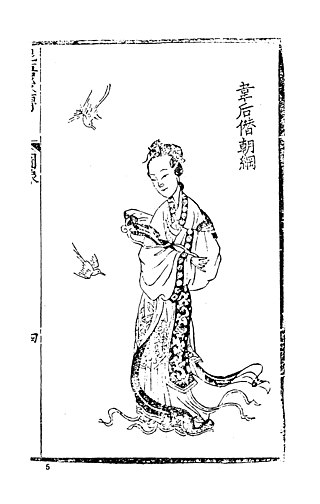
Empress Wei was an empress consort of the Chinese Tang dynasty. She was the second wife of Emperor Zhongzong, who reigned twice, and during his second reign, she tried to emulate the example of her mother-in-law Wu Zetian and seize power. She was de facto in charge of the governmental affairs during her husband's reign, though she was not formally regent. Emperor Zhongzong's death in 710 — a death traditionally believed to be a poisoning she carried out together with her daughter Li Guo'er the Princess Anle — made her the empress dowager, and she took formal power as regent de jure during the minority of Emperor Shang of Tang. After a reign of seventeen days as regent, she was overthrown and killed in a coup led by Emperor Zhongzong's nephew Li Longji and Emperor Zhongzong's sister Princess Taiping.
Li Chongrun, né Li Chongzhao, formally Crown Prince Yide, was an imperial prince of the Tang dynasty and Wu Zetian's Zhou dynasty. He was the only son of Emperor Zhongzong and Emperor Zhongzong's second wife Empress Wei. In 701, he offended his grandmother Wu Zetian by discussing Wu Zetian's lovers Zhang Yizhi and Zhang Changzong with his sister Li Xianhui the Lady Yongtai and her husband Wu Yanji (武延基) the Prince of Wei, and he, along with Li Xianhui and Wu Yanji, were forced to commit suicide. He was posthumously honored as crown prince after his father Emperor Zhongzong was restored to the throne in 705 and in 706, Emperor Zhongzong provided Li Chongrun with an honorable burial by interring his remains at the Qianling Mausoleum.
Li Chongfu (李重福) was an imperial prince of the Chinese Tang dynasty. He was a son of Emperor Zhongzong, but was not favored during Emperor Zhongzong's reign and was exiled. After Emperor Zhongzong's death in 710 and a subsequent coup by Li Chongfu's cousin Li Longji the Prince of Linzi and Li Chongfu's aunt Princess Taiping placed Li Longji's father Emperor Ruizong on the throne, Li Chongfu tried to rise against Emperor Ruizong, to claim the throne himself, but was quickly defeated, and he killed himself by drowning.
Wu Chengsi, courtesy name Fengxian, formally Prince Xuan of Wei (魏宣王), was a nephew of the Chinese sovereign Wu Zetian and an imperial prince of the Wu Zhou dynasty. He participated in her planning in taking the throne and had wanted to become crown prince after she claimed the throne in 690, but his attempts were repeatedly rebuffed, and after she showed her intent to eventually return the throne to her son Li Zhe by recalling Li Zhe from exile in 698, Wu Chengsi died in disappointment.
Zhang Yizhi, formally the Duke of Heng (恆公), nickname Wulang (五郎) and Zhang Changzong, formally the Duke of Ye (鄴公), nickname Liulang (六郎), were two brothers who served as officials of Wu Zetian's Zhou Dynasty and became very powerful late in her reign. Both brothers were killed in a coup that overthrew Wu Zetian in 705.

The Qian Mausoleum is a Tang dynasty (618–907) tomb site located in Qian County, Shaanxi province, China, and is 85 km (53 mi) northwest from Xi'an. Built in 684, the tombs of the mausoleum complex house the remains of various members of the House of Li, the imperial family of the Tang dynasty. This includes Emperor Gaozong, as well as his wife, Wu Zetian, who assumed the Tang throne and became China's only reigning female emperor from 690 to 705. The mausoleum is renowned for its many Tang dynasty stone statues located above ground and the mural paintings adorning the subterranean walls of the tombs. Besides the main tumulus mound and underground tomb of Emperor Gaozong and Wu Zetian, there are 17 smaller attendant tombs, or peizang mu. Presently, only five of these attendant tombs have been excavated by archaeologists, three belonging to members of the imperial family, one to a chancellor, and the other to a general of the left guard. The Shaanxi Administration of Cultural Heritage declared in 2012 that no further excavations would take place for at least 50 years.
Wang Jun (王晙), formally Duke Zhonglie of Zhongshan (中山忠烈公), was a Chinese military general and politician during the Tang dynasty and Wu Zetian's Zhou dynasty, largely known for his service as a general during the reign of Emperor Xuanzong, when he also briefly served as chancellor.

Wu Zi Bei Ge, also known as Wu Zi Bei Ge: Wu Zetian Zhuan, is a 2006 Chinese television series based on the life of Wu Zetian, the only woman in Chinese history to assume the title of "Empress Regnant". The series was directed and written by Chen Yanmin, and starred Siqin Gaowa and Wen Zhengrong as the empress. The series' title Wu Zi Bei Ge literally means "Song of the Uncharactered Stele", with the "stele" referring to the unmarked one standing near Wu Zetian's tomb at the Qianling Mausoleum.

Women of the Tang Dynasty, also known as The World of Tang Women, is a 2013 Chinese television series based on events in the Tang dynasty starting from the late reign of Wu Zetian to Emperor Xuanzong's accession to the throne. The series was produced by Lafeng Entertainment, directed by Chang Hsiao-cheng, and starred an ensemble cast from various regions. Filming for the series started in October 2011 in Hengdian World Studios. The series was first shown on Hunan Satellite TV from 24 August to 23 September 2013.
Empress Zhaocheng (昭成皇后) was the concubine of Emperor Ruizong of Tang and the mother of Emperor Xuanzong of Tang.

Li Jingxun was a 9-year-old princess of the Sui dynasty when she died in 608 CE. Her stone sarcophagus was found undisturbed in 1957 near the Old City in Xi'an, Shaanxi Province, China, at that time named Daxing as the capital of the Sui dynasty.
